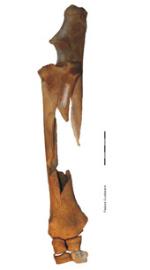Stone Age settlements in the northernmost landscapes
- Spatial analysis of prehistoric settlements in Peary Land and Northeast Greenland

The project 'The Northernmost Stone Age' will be finished in 2008. By now, analysis have been conducted on lithic material as well as on the fauna, and 13 new radiocarbon datings have been conducted on musk ox bones from the most prominent ruins in all parts of the large campsite Pearylandville.
Refitting of bones and lithic material from Pearylandville, have produced several refits. However, all except one are intra-feature-joins where microblade have been refitted on microblade or burin spall has been refitted on burin spall or burin. Among the bones there are numerous refits of marrow-fractured splinters and series of articulated limp bones (see fig. 1). One of these joins, is a refit of a longitudinally split marrow fractured metatarsus of musk oxen (see fig. 2). This refit indicates, that feature 28 and 24 were used simultaneously, and that meat sharing occurred between these two units.
Raw material analysis

Simplified, the raw materials from Pearylandville can be divided in three categories. 1) the dark grey to greenish chert, which is locally available in Johannes V. Jensen Land approximately 150 km as the crow flies to the north of Jørgen Brønlund Fjord and Wandel Dal. 2) a locally available black coarse grained basalt, which primarily were used for the production of axes. 3) a variety of chalcedony types ranging in colour from black to red, green and lighter beige and grey varieties. Presumably all of these are exotic raw materials, since there are only few large primary flakes and just a single nodule of this raw material category. Surprisingly however several ruins are completely dominated by these raw materials and with no signs of the reduction of the Johannes V. Jensen Land chert variety. Presumably this dichotomy reflects genuine differences in raw material availability among the groups or families settling at Pearylandville.

Those leaving behind 1, 2, 3, 4, 5, 6, 7, 10, 15, 16, 20 and 21 all situated at the elevated gravel terraces in the northern part of the site thus must have arrived directly from the northernmost land in Johannes V. Jensen Land or, they must have been in recent contact to other peoples living up there. Those who built ruins 24, 25, 26, 27, 28 and 29 on the other hand appear to have relied on the chalcedony varieties that are known to outcrop in the sedimentary rocks to the south of Independence Fjord or among the sedimentary rocks in the Nares Strait region to the west.
Curiously the two groups of ruins are spatially segregated, so that the ruins dominated by the Johannes V. Jensen Land raw material varieties cluster at the highest gravel terraces whereas the ruins dominated by the multicoloured chalcedony varieties are situated at the lower terraces (see fig. 3). This separation of the ruins with different raw materials could well result from different episodes of settlement. However the spatial pattern seems to make it more likely, that the two groups of ruins were used simultaneous, and that they represent the settling of families from two different regions.

To conclude, the renewed analysis of the spectacular site of Pearylandville support Knuths original interpretation, as an aggregation camp. Furthermore the 13 new radiocarbon datings indicate that the initial occupation of Peary Land only lasted for a short period of time such as a single generation or probably even less.
